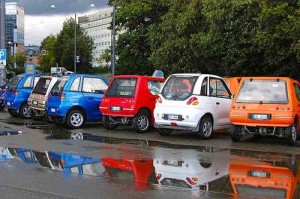 Excerpt from Chapter 1 of Save Gas, Save the Planet: John Addison’s book about hybrid and electric cars, pathways to low carbon driving, and the future of sustainable transportation. © 2009 John Addison. All rights reserved.
Excerpt from Chapter 1 of Save Gas, Save the Planet: John Addison’s book about hybrid and electric cars, pathways to low carbon driving, and the future of sustainable transportation. © 2009 John Addison. All rights reserved.
Your Next Vehicle
Many Americans are going through decisions similar to the Eubanks. They are interested in ending the ridiculous amounts of money they spend at the pump. They do not know whether to get a new vehicle now, or wait for much better fuel economy with future cars such as plug-in hybrids. They want to save gas, but not at the expense of safety.
The decision is easier for those households with two or more vehicles. The vehicle with the best fuel economy can be used to put on the most miles. If all the vehicles are gas guzzlers, this is a great time to replace one.
If you’re ready to buy now, first consider cars that get at least 30 miles per gallon. If you can afford it, don’t settle for less than 40 miles per gallon. Too many people settle for half that mileage or worse, spending thousands of extra dollars each year. You do not need to wait for future technologies or even invest in a full-featured plug-in hybrid, hydrogen, or electric vehicle. Do not let your decision be clouded with claims about ethanol, biodiesel, and flexfuel. Thanks to new designs and materials, most car buyers can afford a car that offers over 30 miles per gallon (mpg).
When you have a few likely candidates, investigate their safety ratings. Safercar.gov rates most cars with one to five stars in the following safety categories: frontal driver, frontal passenger, side driver, side rear passenger, and rollover. High mileage champions like the Toyota Prius score 4 stars, or better, in all categories. The larger Toyota Camry Hybrid scores higher with 5 stars in all categories except a 4 in rollover. The smaller Smart Fortwo scores 3 in some categories. The Ford Escape Hybrid scores 5 in all categories except a 3 in rollover safety. The massive Chevrolet Suburban also scores 5 in all categories except a 3 in rollover safety.
After investigating your needs, fuel economy, and safety, it is highly beneficial to take test drives and even rent your top candidate for a couple of days.
If you can wait until the end of 2010, your choices will be amazing. You will be able to buy a vehicle that gets 100 miles per gallon or a zero-emission electric vehicle.
By going on an energy diet we can have healthy cities, be energy independent, and stop global warming. If we improve gas mileage by only 4 percent annually for 22 years, we could cut vehicle greenhouse gas emissions by 60 percent.
Will improved mileage ever be accomplished? Yes, in fact, in Europe, there are over 100 car models that get 40 miles per gallon. In Asia, over 40 million people drive light electric vehicles – a trend that will be detailed in the next chapter. In the United States, there is tremendous innovation in plug-in hybrid technology, electric drive systems, advanced batteries, and fuel cells.
We are just getting started with fuel economy innovation.
The Loire Valley in France brings images of magnificent castles, breathtaking landscape, superb wine, and driving 10,705 miles per gallon. Yes, you read that right – over 10,000 mpg and the fuel was gasoline. A team of students at La Joliverie won the Shell Eco-Marathon race with this remarkable fuel economy. It was not an electric vehicle. It was not even a hybrid. The vehicle was shaped for minimal wind resistance. The vehicle was also built with new materials that are lighter, stronger, and available in some new models now in car showrooms.
The Loire vehicle would not be practical for many people. It could not go fast. It only held one person. It was so low to the ground that the driver was required to lie flat. However, many vehicles with good mileage are practical.
We have one global trend towards fuel and energy efficiency, and an opposing force towards increased consumption. Our future depends on efficiency being the winner. Amory Lovin’s and his colleagues at the Rocky Mountain Institute have calculated that moving our typical car with its internal combustion engine wastes over 90 percent of the energy content in the gasoline used. If it is a 200-pound driver in a 4,000-pound vehicle, then 98 percent of the energy was not used in moving the person.
Fortunately, there are many solutions. In the chapters that follow we will evaluate fuels that are alternatives to petroleum including ethanol, biodiesel, natural gas, and hydrogen. We will hear from people driving plug-in hybrid vehicles and electric vehicles. The best solution for you depends on your particular needs.
